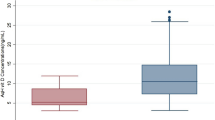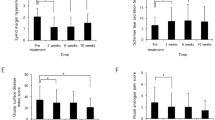Abstract
Purpose
To compare serum 25-hydroxyvitamin D (25(OH)D) levels of patients with dermatochalasis who underwent upper lid blepharoplasty and healthy controls.
Methods
This retrospective comparative study included dermatochalasis patients who underwent upper lid blepharoplasty and age-and sex-matched controls from January 2019 to January 2021. The data, including comprehensive ophthalmological examination, internal medicine outpatient examination, and laboratory results of the dermatochalasis patients and healthy controls, were collected from the electronic patient records. Serum 25(OH)D, creatinine, calcium (Ca), phosphate (P), triglyceride (TG), low-density lipoprotein (LDL), and high-density lipoprotein (HDL) levels were evaluated and compared between the dermatochalasis patients and healthy controls.
Result
Of our participants, consisting of 46 patients with dermatochalasis and 52 healthy controls, 54 (55.10%) were female and 44 (44.90%) were male. A statistically significant difference was observed in vitamin D levels between the healthy and dermatochalasis groups (p ≤ 0.001). The percentage of individuals with vitamin D deficiency (< 20 ng/mL) was significantly higher in the dermatochalasis group (p = 0.001). In addition, the percentage of individuals with severe vitamin D deficiency (< 10 ng/mL) was again significantly higher in the dermatochalasis group (p = 0.001). The risk of dermatochalasis incidence was found to increase in cases of low vitamin D (OR = 1.210; p = 0.017).
Conclusion
Low serum 25(OH)D levels may play a role in the etiopathogenesis of dermatochalasis. Future research should include longitudinal studies and prospective clinical studies to investigate the mechanism responsible for the low vitamin D observed in dermatochalasis patients.

Similar content being viewed by others
References
Karnaz A, Katircioglu YA, Ozdemir ES et al (2018) The Histopathological findings of patients who underwent blepharoplasty due to dermatochalasis. Semin Ophthalmol 33:407–411
Nagi KS, Carlson JA, Wladis EJ (2011) Histologic assessment of dermatochalasis: elastolysis and lymphocytosis are fundamental and interrelated findings. Ophthalmology 118:1205–1210
Brown MS, Siegel IM, Lisman RD (1999) Prospective analysis of changes in corneal topography after upper eyelid surgery. Ophthal Plast and Reconstr Surg 15:378–383
Baylis HI, Golberg RA, Kerivan K, Jacobs J (1997) Analysis and treatment of the aging face. Dermatol Clin 15:635–647
Reichrath J, Saternus R, Vogt T (2017) Endocrine actions of vitamin D in skin: Relevance for photocarcinogenesis of non-melanoma skin cancer, and beyond. Mol Cell Endocrinol 453:96–102
Bikle DD (2020) Vitamin D: Newer Concepts of Its Metabolism and Function at the Basic and Clinical Level. J Endocr Soc.;4:bvz038.
Wadhwa B, Relhan V, Goel K, Kochhar AM, Garg VK (2015) Vitamin D and skin diseases: a review. Indian J Dermatol Venereol Leprol 81:344–355
Toniato E, Spinas E, Saggini A et al (2015) Immunomodulatory effects of vitamin D on skin inflammation. J Biol Regul Homeost Agents 29:563–567
Shab-Bidar S, Neyestani TR, Djazayery A, Eshraghian MR, Houshiarrad A et al (2011) Regular consumption of vitamin D-fortified yogurt drink (Doogh) improved endothelial biomarkers in subjects with type 2 diabetes: a randomized double-blind clinical trial. BMC Med 9:125
Nagpal S, Na S, Rathnachalam R (2005) Noncalcemic actions of vitamin D receptor ligands. Endocr Rev 26:662–687
Hollis BW (2008) Assessment of vitamin D status and definition of a normal circulating range of 25-hydroxyvitamin D. Curr Opin Endocrinol Diabetes Obes 15:489–494
Slominski AT, Zmijewski MA, Plonka PM, Szaflarski JP, Paus R (2018) How UV Light Touches the Brain and Endocrine System Through Skin, and Why. Endocrinology 159:1992–2007
Young AR (2006) Acute effects of UVR on human eyes and skin. Prog Biophys Mol Biol 92:80–85
Akkaya S, Ulusoy DM (2020) Serum Vitamin D Levels in Patients with Keratoconus. Ocul Immunol Inflamm 28(3):348–353
Holick MF, Binkley NC, Bischoff-Ferrari HA et al (2011) Evaluation, treatment, and prevention of vitamin D deficiency: an endocrine society clinical practice guideline. J Clin Endocrinol Metab 96:1911–1930
Kim EC, Han K, Jee D (2014) Inverse relationship between high blood 25-hydroxyvitamin D and late stage of age-related macular degeneration in a representative Korean population. Invest Ophthalmol Vis Sci 55:4823–4831
Choi JA, Han K, Park YM, La TY (2014) Low serum 25-hydroxyvitamin D is associated with myopia in Korean adolescents. Invest Ophthalmol Vis Sci 55:2041–2047
Jee D, Kim EC (2015) Association between serum 25-hydroxyvitamin D levels and age-related cataracts. J Cataract Refract Surg 41:1705–1715
Jee Donghyun, Kang Seungbum, Yuan Changzheng, Cho Eunyoung, Arroyo Jorge G (2016) Serum 25-Hydroxyvitamin D Levels and Dry Eye Syndrome: Differential Effects of Vitamin D on Ocular Diseases. PLOS ONE 11(2):e0149294. https://doi.org/10.1371/journal.pone.0149294
Vitamin D (2015) Implications for ocular disease and therapeutic potential. Reins RY. McDermott AM. Exp Eye Res. 134:101–110
Alia E, Kerr PE (2021) Vitamin D: Skin, sunshine, and beyond. Clinics in Dermatology Clin Dermatol 39:840–846
Colotta F, Jansson B, Bonelli F (2017) Modulation of inflammatory and immune responses by vitamin D. J Autoimmun 85:78–97
Barragan M, Good M, Kolls JK (2015) Regulation of dendritic cell function by vitamin D. Nutrients 7:8127–8151
Stoffels K, Overbergh L, Bouillon R, Mathieu C (2007) Immune regulation of 1alpha-hydroxylase in murine peritoneal macrophages: Unravelling the IFNgamma pathway. J Steroid Biochem Mol Biol 103:567–571
Agliano M, Lorenzoni P, Volpi N et al (2008) Lymphatic vessels in human eyelids: an immunohistological study in dermatochalasis and chalazion. Lymphology 41:29–39
Dozsa A, Karolyi ZS, Degrell P (2005) Bilateral blepharochalasis. J Eur Acad Dermatol Venereol 19:725–728
Daroczy J (1995) Pathology of lymphedema. Clin Dermatol 13:433–444
Sasaki H, Kawakami Y, Ono M, Jonasson F, Shui YB, Cheng HM, Robman L, McCarty C, Chew SJ, Sasaki K (2003) Localization of cortical cataract in subjects of diverse races and latitude. Invest Ophthalmol Vis Sci 44:4210–4214
Sherwin JC, Hewitt AW, Kearns LS, Griffiths LR, Mackey DA, Coroneo MT (2013) The association between pterygium and conjunctival ultraviolet autofluorescence: the Norfolk Island Eye Study. Acta Ophthalmol 91:363–370
Millen AE, Voland R, Sondel SA, Parekh N, Horst RL, Wallace R, B, et al (2011) Vitamin D status and early age-related macular degeneration in postmenopausal women. Arch Ophthalmol. 129:481–489
Gray RH, Johnson GJ, Freedman A (1992) Climatic droplet keratopathy. Surv Ophthalmol 36:241–253
Bilak Ş, Yılmaz S, Bilgin B (2021) Comparison of vitamin D levels between patients with pterygium and healthy subjects. Int Ophthalmol 41:3057–3064
Öktem Ç, Aslan F (2021) Vitamin D Levels in Young Adult Cataract Patients: A Case-Control Study. Ophthalmic Res 64:116–120
Parekh N, Chappell RJ, Millen AE, Albert DM, Mares JA (2007) Association between vitamin D and age-related macular degeneration in the Third National Health and Nutrition Examination Survey, 1988 through 1994. Arch Ophthalmol 125:661–669
Kan E, Kan EK, Yücel ÖE (2020) The Possible Link Between Vitamin D Levels and Exudative Age-related Macular Degeneration. Oman Med J 35:e83
Jee D, Kim EC, Cho E, Arroyo JG (2016) Positive Association between Blood 25-Hydroxyvitamin D Levels and Pterygium after Control for Sunlight Exposure. PLoS ONE 11:e0157501
Rao P, Millen AE, Meyers KJ, Liu Z, Voland R, Sondel S et al (2015) The Relationship Between Serum 25-Hydroxyvitamin D Levels and Nuclear Cataract in the Carotenoid Age-Related Eye Study (CAREDS), an Ancillary Study of the Women’s Health Initiative. Invest Ophthalmol Vis Sci 56:4221–4230
Cougnard-Grégoire A, Merle BM, Korobelnik JF, Rougier MB, Delyfer MN, Féart C, Le Goff M, Dartigues JF, Barberger-Gateau P, Delcourt C (2015) Vitamin D Deficiency in Community-Dwelling Elderly Is Not Associated with Age-Related Macular Degeneration. J Nutr 145:1865–1872
Heaney RP, Davies KM, Chen TC et al (2003) Human serum 25- hydroxycholecalciferol response to extended oral dosing with cholecalciferol. Am J Clin Nutr 77:204–210
Acknowledgements
Res. Asst. Emre Gökay Özgür (statistician) for review of statistics.
Funding
No funding was received for this research.
Author information
Authors and Affiliations
Contributions
Study design, data acquisition, research, manuscript were performed by Sevim Ayça Seyyar, Manuscript editing, research, data acquisition were performed by Ecem Önder Tokuç, All authors read and approved the final manuscript.
Corresponding author
Ethics declarations
Competing interests
The authors declare no competing interests.
Conflict of interest
None of the authors have any financial/conflicting interests to disclose.
Ethics committee number
Derince Training and Research Hospital ethics committee 2022–22.
Additional information
Publisher's Note
Springer Nature remains neutral with regard to jurisdictional claims in published maps and institutional affiliations.
Rights and permissions
Springer Nature or its licensor holds exclusive rights to this article under a publishing agreement with the author(s) or other rightsholder(s); author self-archiving of the accepted manuscript version of this article is solely governed by the terms of such publishing agreement and applicable law.
About this article
Cite this article
Seyyar, S.A., Tokuc, E.O. Evaluation of 25-Hydroxyvitamin D levels in patients with dermatochalasis. Int Ophthalmol 43, 749–756 (2023). https://doi.org/10.1007/s10792-022-02474-4
Received:
Accepted:
Published:
Issue Date:
DOI: https://doi.org/10.1007/s10792-022-02474-4




